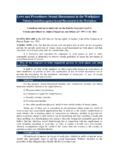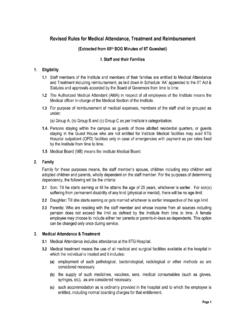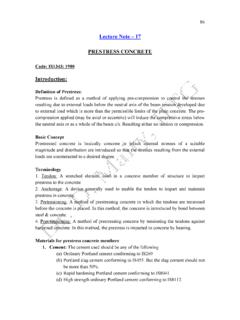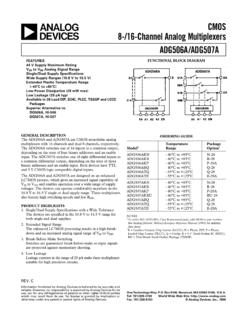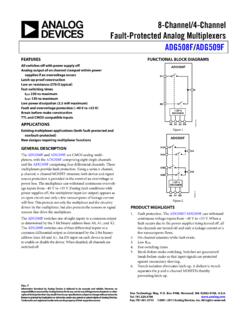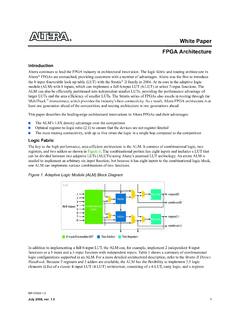Transcription of Optical Networks – Basic Concepts (Part 1)
1 Optical Networks Basic Optical Networks Basic Concepts (Part 1)Introduction What is an Optical network? Optical devices and components Basic Concepts in Optical networking Optimization of Optical network design Optimization of Optical network design How to handle faults in Optical Networks ? Some recent research topicsWhat is an Optical network? An ptica etw r connects computers (or any other device which can generate or store data in electronic form) using Optical fibers. ptica fibersare essentially very thin glass cylinders or filaments which carry signals in the form of light ( Optical signals).
2 A transmitter connected to a receiver in an Optical networkOptical to Electrical signalElectrical to Optical SignalFiber (s)TransmitterReceiver4A lit-up bundle of fibersGlobal Optical Fiber Network5 Why do we need Optical Networks ? Demand for bandwidth The tremendous growth of connected users online More and more bandwidth+intensive network applications: More and more bandwidth+intensive network applications: data browsing on the WWW Applications requiring large bandwidth video conferencing download movieAdvantages of Optical Networks High speed capability (theoretically possible to send 50 Terabits per second using a single fiber)
3 Low signal attenuation Low signal distortion Low power requirement Low power requirement Low material usage Small space requirements Low cost Immunity to electrical interferenceOptical Devices/components Optical Fiber consists of a cylindrical core of silica, with a refractive index 1, surrounded by cylindrical cladding, also of silica, with a lower refractive index 1: A fiberAn Optical Fiber 9 Figure 2: Structure of an Optical FiberPropagation of a signal through a fiber How does an Optical signal move through a fiber network send the Optical signal at an angle greater than the critical angle sin+1 2/ 1.
4 Optical signals propagate through the core using a series of total internal 3: Propagation using total internal reflectiobnOptical fibers (Cont d) data communication in an Optical network use an Optical carrier signal at some wavelength in the band of 1450 to 1650 nm, at the source of the data, modulate the carrier with the data to be communicated, send the modulated carrier towards the destination using a path involving one or more fibers,involving one or more fibers, when the signal reaches the destination, extract the data from the incoming signal using Division Multiplexing The technology of using multiple Optical signals on the same fiber is called wave e gth divisi u tip exi g(WDM).
5 WDM Optical Network Divide the vast transmission bandwidth available on a fiber into several different smaller capacity channels non+overlapping bandwidths, Each of these channels can be operated at a moderate bit rate ( +40 Gb/s) that electronic circuits can handle,Gb/s) that electronic circuits can handle, Each of these channels corresponds to a different carrier spectrum of fibersUsable BandwidthsFigure 4: Transmission spectrum of Optical fibers. In WDM Networks , each signal on a fiber is given a fixed bandwidth.
6 In order to avoid interference between signals, a fixed spacing is maintained Channel spacing or guard band in WDMC hannel spacing or guard band in WDMspacing is maintained between signals using adjacent bandwidths, called as guard band . Signal Bandwidth = 10 GHz Channel Spacing = 100 GHz14 Figure 5: channels on a fiberData Transmission in WDM Networks Carrier Frequency:15 Digital Data Modulated 6: Modulated Optical signalWhat do we need to achieve WDM What do we need to achieve WDM CommunicationCommunicationTransmitter convert data to a modulated Optical signalReceiver Convert a modulated Optical signal to dataMultiplexer to combine multiple Optical signalsDemultiplexer to separate signals having different carrier wavelengthsRouters to direct the signals from the source to the destinationAdd- drop multiplexers to add new signals to a fiber and extract some signals16 Figure 7.
7 Wavelength Division Multiplexing (WDM)MultiplexerDe-MultiplexerCombine OpticalsignalsOptical fiberSeparate OpticalsignalsOptical Devices/components multiplexer (MUX) has a number of inputs, each carrying signals using a distinct channel. generates an output that combines all the 8: A 4+input MultiplexerOptical Devices/components Demultiplexer(DEMUX) serves the opposite purpose ++ its input is a fiber carrying n Optical signals, with the ithsignal using channel ci. has at least m outputs, with the ithoutput carrying the Optical signal using channel ci, for all i; 1 i ci, for all i; 1 i 9: A 4+output DemultiplexerOptical Devices/components Optical add+drop multiplexer (OADM) ADM: A pair consisting of a MUX and a DEMUX, where some of the outputs from the DEMUX are not connected to any of the inputs of the MUX.
8 Each output of the DEMUX, not connected to an input of the connected to an input of the MUX, is connected to a receiver. Each input to the MUX which is not connected to an output of the DEMUX is connected to the output of a transmitter/modulator. Add+drop multiplexers using Optical devices are called Optical Add/drop Multiplexers (OADM).Figure 10: An Optical add+drop multiplexer (OADM) Optical Devices/components End nodes: sources or destinations of data (typically computers). Optical routers:direct each incoming Optical signal to an appropriate outgoing Devices/components End node Ex(Ey) has transmitters (receivers) ti.
9 Tj(ri,..rj)tuned to wavelengths i, .., j. The data in electronic form is the input to transmitter ti, and is converted to Optical signals using wavelength i. The Optical signal using iis routed The Optical signal using iis routed through a number of intermediate end+nodes Ep,Eq,..,Erto the destination 12: Use of add drop multiplexers and demultiplexersOptical Devices/components Tasks of End-Node receive Optical signals from the preceding node, separate the different Optical signals on the input fiber, Convert incoming signals, intended for itself to electronic form, forward, without electronic processing, other incoming signals intended for other incoming signals intended for other end-nodes, convert, to Optical signal(s), electronic data that have to be communicated to other end-node(s)
10 , combine the Optical signals send these Optical signals using the outgoing fiber from 12: Use of add drop multiplexers and demultiplexersPoint to point communication in an Optical NetworkFigure 11: Point to point communication in an Optical networkTypes of WDM Networks Categorizations of WDM Networks Broadcast+and+select Networks Wavelength+Routed NetworksBroadcast+and+select Networks Typically a local network with a small number (NE) of end+nodes, Each end+node equipped with one or more transmitters and receivers. All the end+nodes are connected to a passive star coupler.
